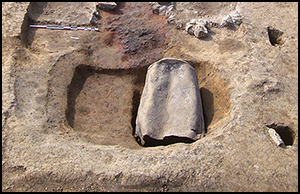No CrossRef data available.
Published online by Cambridge University Press: 21 November 2016

The rare discovery of a well-preserved miliarium—a water boiler—in a rural bath house in Gaul suggests that the technology of water supply had penetrated the remoter parts of the Roman world. Such boilers were frequently recycled for their valuable metal content. This example, by contrast, was buried close to where it once stood—perhaps in connection with the ritual deposit of complete animal carcasses around the bath house. The symbolic associations of the boiler are suggested by decorative elements including the mask of a bearded man, argued to represent Okeanos, a divine personification of the sea. The near-complete state of the boiler also provides new insight into the processes used in its manufacture from lead and copper alloys.